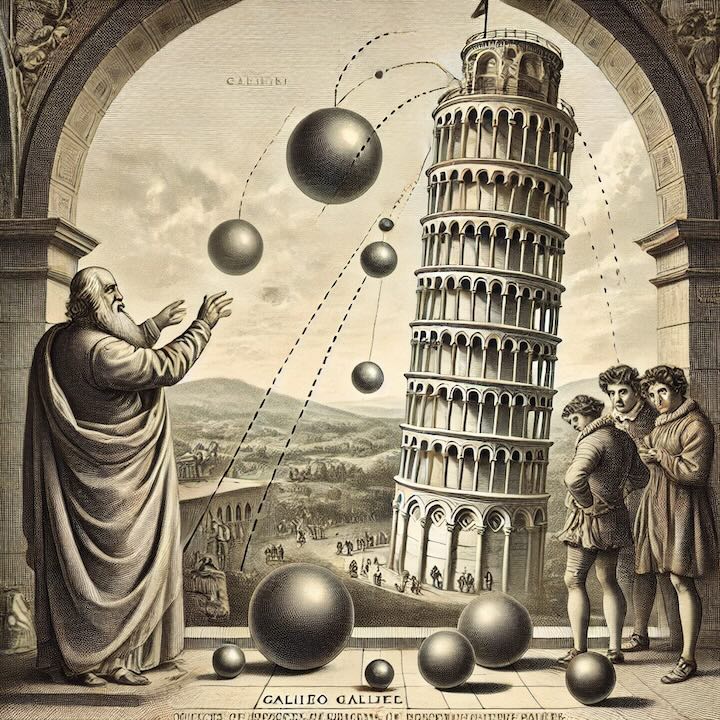1638 Galileo Explains Principles Falling Bodies

In 1638 Galileo published Discorsi e Demonstrazione Matematiche Intorno a Due Nuove Scienze. This worked presented the mathematical principals of falling bodies and projectile motion.
In 1638, Galileo Galilei, the Italian mathematician, physicist, and astronomer, published one of his most influential works, Discorsi e Dimostrazioni Matematiche Intorno a Due Nuove Scienze (Dialogues Concerning Two New Sciences). Written during the last years of his life while he was under house arrest, this book marked a culmination of Galileo’s work and presented groundbreaking ideas that laid the foundation for modern physics. Through this work, Galileo addressed two “new sciences”: the science of motion (kinematics) and the science of material strength, which he developed as he studied the behavior of objects in motion and structural integrity.
One of the primary achievements of Two New Sciences was Galileo’s establishment of the mathematical principles of falling bodies and projectile motion. Prior to Galileo, the prevailing view, based on Aristotelian physics, held that heavier objects fell faster than lighter ones. Galileo, however, challenged this belief by proposing that, in the absence of air resistance, all objects would fall at the same rate regardless of their mass. He conducted experiments, including his famous (though debated) experiment at the Leaning Tower of Pisa, to show that objects of different weights fall at the same rate when dropped simultaneously. This idea laid the foundation for the concept of uniform acceleration, which was later formalized in the law of gravitational acceleration.
In Two New Sciences, Galileo also introduced the idea of inertia. He observed that an object in motion would remain in motion unless acted upon by an external force, which contradicted the Aristotelian idea that a force was necessary to maintain motion. This concept of inertia was a critical precursor to Newton’s First Law of Motion, and Galileo’s work in this area was instrumental in shifting scientific thinking away from Aristotelian principles toward a more empirical, observation-based approach.
Galileo’s study of projectile motion was equally revolutionary. He demonstrated that a projectile’s trajectory follows a parabolic path, a concept that combined both vertical and horizontal motion. According to Galileo, the horizontal motion of a projectile is independent of its vertical motion, which he showed through experiments and mathematical analysis. By separating these two components of motion, Galileo was able to explain the behavior of objects in free fall and develop the first accurate description of how projectiles move. This work was instrumental in fields like ballistics and engineering and laid the groundwork for later studies on motion.
In addition to these achievements, Two New Sciences also explored the strength of materials and how they relate to the size and structure of objects. Galileo observed that larger structures are more vulnerable to breaking under their own weight due to the relationship between their volume and surface area, which he presented through a series of discussions and thought experiments. This insight into the strength of materials would eventually influence fields like architecture, engineering, and materials science.
Galileo’s Two New Sciences had a profound impact on the development of modern physics and the scientific method. By focusing on observation, experimentation, and mathematical analysis, Galileo shifted the scientific community away from speculative reasoning and toward empirical evidence. His work not only laid the groundwork for Newtonian physics but also contributed to a broader intellectual movement that emphasized reason and observation as tools for understanding the natural world.
Published during a time of personal hardship and conflict with the Church, Two New Sciences stands as a testament to Galileo’s resilience and intellectual courage. Despite being under house arrest and facing censorship for his previous works, Galileo continued to push the boundaries of knowledge, leaving an indelible mark on science. His work on motion, projectile behavior, and material strength remains foundational to physics, and Two New Sciences is considered one of the most important scientific texts of the 17th century.
 >
>